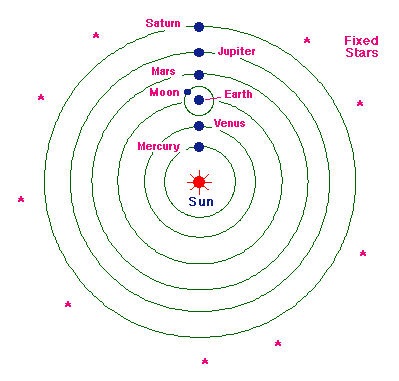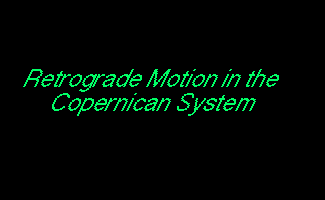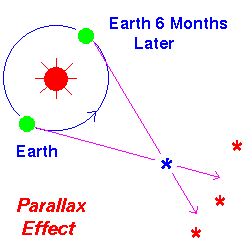| |
In a book called On the Revolutions of the Heavenly Bodies (that was published
as Copernicus lay on his deathbed), Copernicus proposed that the Sun, not the
Earth, was the center of the Solar System. Such a model is called a
heliocentric system. The ordering of the planets known to Copernicus
in this new system is illustrated in the following figure, which we recognize as
the modern ordering of those planets.
 |
| The Copernican Universe |
In this new ordering the Earth is just another planet (the third outward from
the Sun), and the Moon is in orbit around the Earth, not the Sun. The stars
are distant objects that do not revolve around the Sun. Instead, the Earth
is assumed to rotate once in 24 hours, causing the stars to appear to revolve
around the Earth in the opposite direction.
Retrograde Motion and Varying Brightness of the Planets
The Copernican system by banishing the idea that the Earth was the center of
the Solar System, immediately led to a simple explanation of both the varying
brightness of the planets and retrograde motion:
- The planets in such a system naturally vary in
brightness because they are not always the same distance from the Earth.
-
The retrograde motion could be explained in terms of geometry and a faster
motion for planets with smaller orbits, as illustrated in the following
animation.
 |
| Retrograde motion in the Copernican System |
A similar construction can be made to illustrate retrograde motion for a planet
inside the orbit of the Earth.
Copernicus and the Need for Epicycles
There is a common misconception that the Copernican model did away with the
need for epicycles. This is not true, because Copernicus was able to rid
himself of the long-held notion that the Earth was the center of the Solar
system, but he did not question the assumption of uniform circular motion.
Thus, in the Copernican model the Sun was at the center, but the planets still
executed uniform circular motion about it. As we shall see later, the orbits
of the planets are not circles, they are actually ellipses. As a consequence,
the Copernican model, with it assumption of uniform circular motion, still
could not explain all the details of planetary motion on the celestial sphere
without epicycles. The difference was that the Copernican system required many
fewer epicycles than the Ptolemaic system because it moved the Sun to
the center.
The Copernican Revolution
We noted earlier that 3 incorrect ideas held back the development of modern
astronomy from the time of Aristotle until the 16th and 17th centuries: (1)
the assumption that the Earth was the center of the Universe, (2) the
assumption of uniform circular motion in the heavens, and (3) the assumption
that objects in the heavens were made from a perfect, unchanging substance not
found on the Earth.
Copernicus challenged assumption 1, but not assumption 2.
We may also note that the Copernican model implicitly questions the third tenet that
the objects in the sky were made of special unchanging stuff.
Since the Earth is just another
planet, there will eventually be
a natural progression to the idea that the planets are made
from the same stuff that we find on the Earth.
Copernicus was an unlikely revolutionary. It is believed
by many that
his book was only published at the end of his life because he feared
ridicule and disfavor: by his peers and by the Church, which had elevated the
ideas of Aristotle to the level of religious dogma.
However, this reluctant revolutionary set in
motion a chain of events that would eventually (long after his lifetime)
produce the greatest revolution
in thinking that Western civilization has seen.
His ideas
remained rather obscure for about 100 years after his
death. But, in the 17th century the work of Kepler, Galileo, and Newton
would build on the heliocentric Universe of Copernicus and produce the
revolution that would sweep away completely the ideas of Aristotle and replace
them with
the modern
view of astronomy and natural science. This sequence is commonly called the
Copernican Revolution.
Been There, Done That: Aristarchus of Samos
The idea of Copernicus was not really new!
A
sun-centered Solar System had been proposed as early as about 200 B.C. by
Aristarchus of Samos
(Samos is
an island off the coast of what is now Turkey).
However, it did not survive long under the weight of Aristotle's influence and "common sense":

-
If the Earth actually spun on an axis (as required in a heliocentric system to
explain the diurnal motion of the sky), why didn't objects fly off the spinning
Earth?
-
If the Earth was in motion around the sun, why didn't it leave
behind the birds flying in the air?
-
If the Earth were actually on an orbit around the sun, why wasn't a parallax
effect observed? That is, as illustrated in the adjacent figure, stars
should appear to change their position with the respect to the other
background stars
as the Earth moved about its orbit, because of viewing them from a different
perspective (just as viewing an object first with one eye, and then the other,
causes the apparent position of the object to change with respect to the
background).
The first two objections were not valid because they represent an inadequate
understanding of the physics of motion that would only be corrected in the 17th
century. The third objection is valid, but failed to account for what we now
know to be the enormous distances to the stars.
As illustrated in the following figure, the amount of parallax decreases with
distance.
 |
| Parallax is larger for closer objects |
The parallax effect is there,
but it is very small because the stars are so far away that
their parallax can only be observed with very precise instruments.
Indeed, the parallax of stars was not measured conclusively until
the year 1838. Thus, the heliocentric idea of Aristarchus was quickly
forgotten and Western thought stagnated for almost
2000 years as it waited for Copernicus
to revive the heliocentric theory.
|


